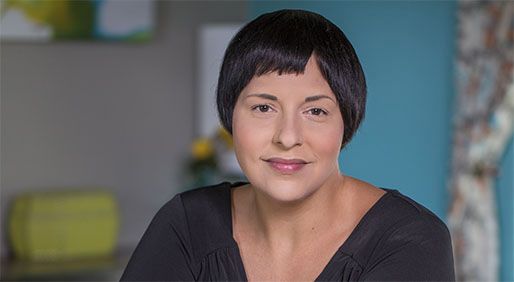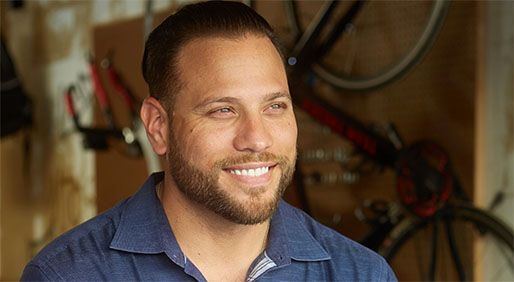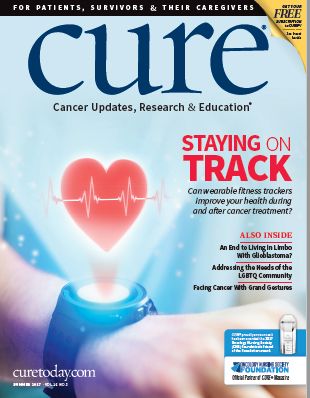Publication
Article
CURE
Patients With Cancer Find Purpose in Radical Feats
Author(s):
For some diagnosed with cancer, doing something radical can instill meaning and a sense of purpose.
IAN TOOTHILL, 47, a personal trainer from London, found out he had stage 4 bowel cancer in early 2015. Doctors told him he wouldn’t live out the year, but by Christmastime, his cancer had disappeared.
A few months later, in 2016, the cancer was back. His medical team told him there wasn’t much left to do. But then, the cancer stopped progressing. So Toothill did what any stage 4 cancer patient would do: He decided to climb Mount Everest to raise money for Macmillan Cancer Support, a British charity.
Yes, that Mount Everest. Despite a knee injury and two illnesses that required antibiotics, Toothill progressed up the world’s tallest peak, posting to his Facebook page (business.facebook. com/climbingeverestforcancer) and racking up GoFundMe donations, for several months, and reached the summit on June 4. He has already exceeded the amount needed to pay for his trip, and he hopes to go on to raise more than $322,000 to fund medical care, information and support for those affected by cancer.
“He’s walked across Iceland by himself. He’s climbed the Alps. He’s been to Antarctica. The diagnosis made him think, ‘I’ve got to do this now: I’ve got to climb Everest,’” explains James Hodgson, a friend who helped to coordinate Toothill’s effort from London. “He’s an incredible guy: incredibly strong, incredibly positive.”
Something about hearing those words — “You have cancer” — tends to focus the mind and, in some, to inspire radical responses. In 2013, a San Francisco doctor made headlines by organizing a flash mob dance, jumping off her gurney and rocking out to Beyoncé’s “Get Me Bodied” moments before her double mastectomy. The video of her dance party (https://tinyurl.com/yblwkcjc) went viral. Last fall, a woman in Alpharetta, Georgia, wore different costumes — Wonder Woman, Batgirl and so on — to each chemo infusion. A young patient with breast cancer this spring gave a huge party for her breasts before her double mastectomy.
In May, pancreatic cancer survivors jumped out of an airplane at 13,000 feet to raise awareness about this deadly form of cancer.
“Most people cope by falling back on what they’ve always done, whether it’s to be spiritual, to be intellectual, to find comfort in family,” says Laura Howe-Martin, Ph.D., a clinical psychologist and an associate professor at the University of Texas Southwestern Medical Center, in Dallas. “A few take on extraordinary things: They start charities or start running triathalons. They divorce, or they quit what they thought was their dream job. They get more religious, or less religious. People who have cancer are ready, ready to make meaningful changes.”
Taking on a big project or making a big change is also one way of altering a personal storyline, experts say. It’s a way of asserting a little bit of control over something we really can’t control at all: our own mortality. Counselors say people usually take on these efforts soon after diagnosis, or just after finishing active treatment.
“It gives a renewed sense of purpose for the person. The person who has cancer is defining who they are and what they want to do. They are doing the things that are most meaningful to them,” explains Bruce Cameron, a clinical and forensic counselor in Dallas. When Cameron’s sister was dying of breast cancer, she decided to travel around South America playing Latin jazz.
In the past decade or two, a whole scientific literature has developed to explore this phenomenon. Generally, studies fall under two scientific rubrics: “post-traumatic growth,” or experiencing some psychosocial growth after a trauma, and “benefit seeking,” which is an academic way of saying “finding the silver lining.”
In general, the studies seem to show that people who see their cancer as an opportunity for growth or change, or who eventually conclude that some good things can come out of having cancer, tend to experience less depression and anxiety. This seems to be true for people with many different types of cancer, both during treatment and during the transition into survivorship. There’s some thought that these coping strategies may even result in better health outcomes. While this makes emotional sense to many of us, there is not yet clear scientific evidence proving that optimism and purpose directly affect health Here are the stories of three people who went to extraordinary lengths to shift their cancer narratives:
GIVING BACK
KELLI PARKER’S cancer diagnosis inspired her to spearhead masquerade balls that have helped raise hundreds of thousands of dollars for research into metastatic breast cancer. - BETH HALL

KELLI PARKER’S cancer diagnosis inspired her to spearhead masquerade balls that have helped raise hundreds of thousands of dollars for research into metastatic breast cancer. - BETH HALL
Kelli Parker was only 26 when she received a stage 1 breast cancer diagnosis. She had a mastectomy, chemotherapy and radiation, and was then free of cancer. She married, had a child and developed a career as an executive at Walmart headquarters in Arkansas. Then five years later, when she was 31, the cancer came back, spreading to her bones.
When Parker, now 35, first learned that her cancer would eventually end her life, Parker fell into a depression so deep that she had to be hospitalized. “I freaked out a bit,” she says. “I was terrified to go on living. I need to fix things before I can move on. I can’t fix this. Actually, being hospitalized was good for me. It forced me to focus on something else. I had to train myself to stop ruminating on the things that scare me.”
As she recovered from her initial shock, Parker gradually became well enough to go back to work. Then she started to advocate for patients with metastatic breast cancer. She went to the most influential breast cancer organizations, but didn’t get the response she wanted.
“It was frustrating,” Parker says. “People don’t die of early-stage breast cancer. They die of metastatic breast cancer. Thirty percent of early-stage breast cancers will metastasize. For me and for many others, there is no life after breast cancer, and right now only a small percentage of research money goes to metastatic breast cancer. I just want 30 percent of the research money to go to the 30 percent who will become stage 4. What makes a cancer cell go metastatic? What pathways can we use to target that metastatic cell? How can we better manage metastatic disease?”
Parker participated in “Don’t Ignore Stage Four” and other awareness campaigns on Facebook. Meanwhile, she was looking for organizations that shared her passion. She found METAvivor, a Maryland nonprofit organization started by four women with advanced breast cancer, and decided to use her business sense to try to help them conduct research, raise awareness and acknowledge the men and women with the disease.
One day, Parker was brainstorming about fundraising projects and hit upon the notion of a masquerade ball. Why not call it Metsquerade? she thought. She posted something on Facebook about the idea and soon heard from Lisa Quinn, who had recently been diagnosed with stage 4 breast cancer and wanted to help. The two launched the event in their own region, Northwestern Arkansas, to benefit METAvivor.
It took them four months to partner with businesses like Walmart near Parker’s home, enlist a local TV station to take up the cause and plan the glamorous charity ball. Held in April 2016, Metsquerade raised $100,000 for metastatic research, Parker says; the April 2017 ball raised $300,000, and the goal for the 2018 gala is $500,000.
To help meet this goal, Parker and her team have enlisted people from around the country to participate in the METAribbon challenge, which allows patients with metastatic disease to tell their stories and raise money through personal Metsquerade pages on Facebook. In addition, METAvivor created a Metsquerade manual, and now these events have been scheduled in Raleigh-Durham, North Carolina, and Naples, Florida, Parker says. In addition, she says, Metsquerade teams are in the initial planning phases in Chicago, Dallas, Cleveland and the San Francisco Bay Area.
“All these events feed into the METAvivor bucket,” Parker explains. “We need to be raising $20 to $30 million a year to drive substantial research grants.”
Having helped METAvivor increase its available funding for a variety of cancer research grants, Parker says, “I could not be prouder of the work we’re doing. It makes me realize that it’s not all about me; it’s about a much larger cause. We’re not special; we’re just women who want to be alive to see our daughters go to school. We’re going to do something while we can.”
CONQUERING A CHALLENGE
It sounds complicated, but really, it’s simple: It’s about not giving up,” says CLAY TRESKA, who completed the Ironman World Championship after a stem cell transplant for stage 4 testicular cancer. - PHOTO BY: ROB ANDREW

It sounds complicated, but really, it’s simple: It’s about not giving up,” says CLAY TRESKA, who completed the Ironman World Championship after a stem cell transplant for stage 4 testicular cancer. - PHOTO BY: ROB ANDREW
After returning from combat with the U.S. Marine Corp in Iraq, Clay Treska, then 29, was looking forward to a bit of down time in 2008. Then another battle presented itself: stage 1 testicular cancer. Following a grueling year of treatment, Treska started training for a triathlon.
“I’d gotten out of shape during chemo,” he says. But while working out in January 2009, Treska started to have severe pains in his lower back. By July 2009, he was in the hospital with stage 4 disease.
“I was doing my will, being transferred to hospice,” says Treska, now 37. “Then a friend of my father’s suggested a second opinion.”
Peter T. Curtin, M.D., an oncologist/ hematologist at the University of California San Diego (UCSD), suggested that Treska try an autologous stem cell transplant. In this procedure, a patient’s blood-forming stem cells are collected; then the patient undergoes high-dose chemotherapy and/or radiation, killing both cancer cells and healthy cells in the bone marrow. The healthy stem cells are then transferred back into the patient, and hopefully grow into healthy tissue. While often lifesaving, the process takes months and can bring many to the very edge of their endurance.
Treska decided that he wouldn’t stop training during his stem cell transplant, even as his weight plummeted from 250 to 140 pounds. Instead, he regularly checked himself out of the hospital to compete in races that would qualify him for the Ironman World Championship in Hawaii, a 112-mile cycle race, a marathon and a 2-mile swim — all in the same day.
“I learned to bike and swim (while living) in the hospital. It was my way of saying, ‘F--- you, cancer. If I’m going to die, I’m going to do it pursuing what I always wanted to do,’” Treska says. “I felt terrible the entire time. The hardest part was not telling anyone how sick I was. I had to have everyone’s confidence that it was feasible.”
Treska checked out of the hospital in August 2010. He completed the Hawaii Ironman in October of that year, finishing half of the bike race and the marathon on a sprained ankle.
“I have a high tolerance for pain,” Treska says, in what might be one of the biggest understatements ever. “The hardest part wasn’t the exercising; it was the emotional trauma of going through the disease.”
Treska remains free of the diseases. He became an efficiency specialist for the UCSD health system and has just been accepted to the business school there. He hopes to eventually be part of the oncology service executive team. “It sounds complicated, but really, it’s simple: It’s about not giving up,” Treska says. “You’re fighting for the people you care about.”
LEAVING A LEGACY
Paulette Sherman, a psychologist in New York City, was 41 when she was diagnosed with triple-negative, stage 2 breast cancer. She went for a walk on the beach near her home and prayed, asking if she was going to live, and if she had achieved her life’s purpose. She reflected on the fact that she’d accomplished many of her goals: publishing a book, marrying her soulmate, having kids, having a satisfying career and a house near the sea.
Then, she says, an internal voice told her that she should leave a legacy of 22 more books. From idea to manuscript to book in hand can take two or more years with a traditional publisher. Sherman decided she didn’t have that kind of time. So she started her own publishing company, Parachute Jump, after the Coney Island ride not far from her home.
“This project gave me hope,” Sherman says. “I was triple-negative, and if the cancer spread, I would be on chemo for the rest of my life. I was scared. My kids were so young, both under 4. I just knew I was going to do this. If I may not be here someday, I would leave these books behind.”
Sherman then embarked on an output that would be impressive for someone who wasn’t sick with cancer, book after book: “My Quick Guide Through Breast Cancer,” “The Cancer Path,” “60+ Inexpensive NYC Date Ideas,” “When Mars Women Date,” “How to Create a Fantastic Fairy Tea Party,” “How to Use Your iPad as a Life Coach.” Some were about career, some about romance, some on topics that were interesting to her kids. Some were very short, just 20 pages, others much longer.
“The most challenging thing about my effort was that the people in my extended family thought this was a crazy idea because of the time, energy and money it would take,” Sherman says. “But it gave me a passionate mission to focus on during the year of treatment.”
Sherman’s books have been translated into Czech, Korean, Italian and Chinese. In 2016, a traditional publisher, Llewellyn, published her latest work: “The Book of Sacred Baths.”
FINDING A TAKEAWAY
Experts caution that these grand gestures make good stories but usually take money, education and an extensive support network that might not be available to everyone.
“A lot of people feel that pressure, and we’re more often trying to talk people down from that pressure,” says Teresa DeShields, Ph.D., manager of counseling services at the Siteman Cancer Center at the Washington University School of Medicine in St. Louis. “Maybe the big accomplishment is just getting back to your life, rather than succumbing to the pressure to do something profound.”
Experts also point out that those who do grand projects are just building on personality traits they had to begin with, such as an interest in fitness, an action-oriented lifestyle or a commitment to volunteer work.
“These projects are an extension of who somebody is,” explains Ellen Ormond, Ph.D., of the Center for Counseling and Cancer Support at the University of Pittsburgh. “The cancer diagnosis just says, ‘How can I use my strengths to deal with my anxiety and make the world a better place?’”






